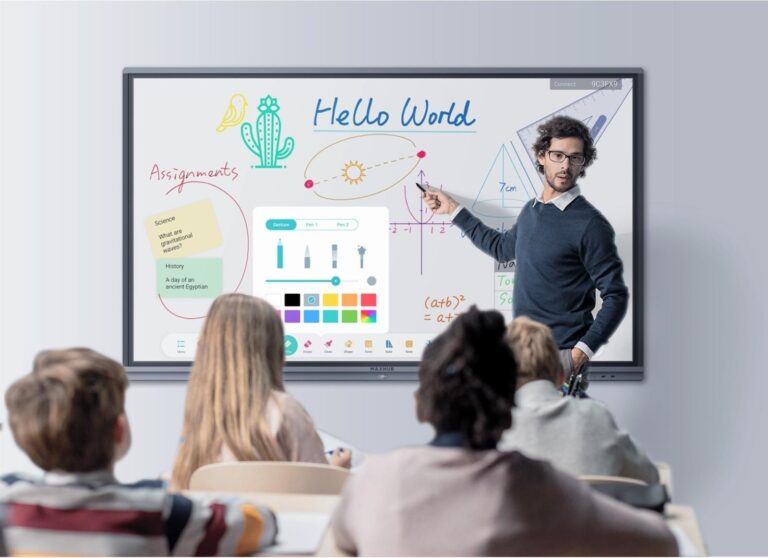The Digital Classroom creates an exciting educational environment where technology seamlessly blends with learning to enrich both teaching and student experiences. This dynamic space plays a vital role in modern education, especially in online settings like Lady Evelyn Online Independent School. In a digital classroom, technology becomes an essential part of the learning journey, ensuring that students aged 8 to 18 find their education both accessible and engaging.
How Learning Works in a Digital Classroom
The essence of a Digital Classroom lies in its ability to transform traditional learning spaces into interactive and immersive environments. In a Digital Classroom, learning is facilitated through the integration of various digital tools and platforms, allowing students to engage with the material dynamically. This transformation is achieved by leveraging technology to cater to different learning styles, ensuring every student can benefit from a personalised educational experience.
Digital Classroom is designed to blend both virtual and physical elements to create an engaging educational space. Students have access to a range of edtech tools such as tablets, laptops, and smart whiteboards, streamlining the learning process and making it more interactive. These devices are essential in facilitating immediate access to information, enabling students to conduct research, collaborate on projects, and apply critical thinking skills in real-time.
The role of the teacher in a Digital Classroom is also crucial, as educators guide students through their learning journey using technology as a conduit for understanding. Teachers are empowered to create high-quality lesson plans incorporating virtual reality experiences, enriching the curriculum with new dimensions of possibility and insight. This approach enhances knowledge retention and fosters an environment where students are encouraged to explore and discover at their own pace.
Moreover, a significant benefit of the Digital Classroom is its accessibility and inclusivity. Students of varying abilities can access tailored educational materials, ensuring no student is left behind. Adaptive technology enables differentiation, allowing educators to modify content to meet individual needs, thereby supporting a more comprehensive learning experience.
In conclusion, learning in a Digital Classroom is a highly engaging process that aligns with the digital age’s demands. Through thoughtful integration of technology and an emphasis on collaboration and interactive experiences,
Essential Elements of a Digital Classroom
Devices such as laptops, tablets, and interactive whiteboards might form the core of a digital classroom. Software solutions such as Google Classroom
Benefits of Digital Classrooms
Digital classrooms offer many benefits, including increased access to persons with disabilities and students far away. Media devices such as Videos or simulations allow students to engage actively in learning, making it memorable.
Challenges and Solutions
The major challenge remains the failure of the divide on internet use; some people need this opportunity. Schools are solving this problem by giving devices and securing the Internet for underprivileged kids.
Artificial Intelligence Integration into Education
Thanks to artificial intelligence (AI), personalised pathways to learning based on individual students’ needs and performance have revolutionised the education landscape today. AI also helps teachers automate routine tasks such as grading.
Role Played By The Internet In Digital Learning
The Internet is mandatory in a digital classroom because it provides broad-scale resources for students globally, including students and teachers collaborating internationally on various projects.
Virtual Reality (VR) and Augmented Reality (AR) in Education
The use of VR alongside AR makes subjects that are thought to be hard, like anatomy, astronomy, etc., accessible in teaching practices that involve immersion within them, making them more engaging.
Assessment and Feedback in a Digital Age
Digital tools can give real-time data on student engagement, understanding, and progress so that teachers can provide timely and specific feedback.
Blended Learning Models
Blended learning models combine traditional teaching methods with digital solutions to provide a well-balanced approach that accommodates different types of learners.
FutureTrends in Digital Education
Emerging technologies like Blockchain and the Internet of Things (IoT) are expected to transform education significantly.
Teacher’s Role in the Digital Classroom
Teachers need to adjust themselves as new instructional tools and approaches emerge. Professional development is essential for them to keep up with technology.
Student Engagement and Digital Tools
Digital tools can improve student involvement by providing interactive learning experiences where students work together. According to students, these tools make learning more fun and relevant.
Conclusion
Incorporating a Digital Classroom within an educational environment brings numerous advantages, helping to align traditional learning spaces with 21st-century demands.
With technology becoming increasingly integral to everyday life, understanding and utilising the Digital Classroom aids in preparing students for the future.
This innovative approach enhances the learning experience and facilitates personalised learning paths, accommodating diverse educational needs.
The success of a Digital Classroom hinges on strategic integration and continuous adaptation of technological advancements, and we are committed to maintaining this forward-thinking ethos.
Ultimately, the Digital Classroom helps empower students, fostering an enriched, interactive, and dynamic learning experience that truly reflects the potential of modern education.
FAQs
The concept of a Digital Classroom has transformed traditional education, making it essential for students and educators to adapt. Here, we address some of the frequently asked questions about Digital Classrooms.
What is a Digital Classroom?
A Digital Classroom is an educational environment where technology aids teaching and learning. It incorporates digital tools like tablets, smart whiteboards, and learning software to enhance the academic experience.
How does a Digital Classroom differ from a traditional classroom?
Unlike traditional classrooms, Digital Classrooms have technological resources that facilitate interactive and remote learning. They allow for greater accessibility and personalisation and accommodate various learning styles.
What are the benefits of using a Digital Classroom?
Digital Classrooms provide numerous benefits, including increased accessibility, flexible learning opportunities, and the ability to incorporate multimedia resources. They empower students to learn independently and offer teachers innovative ways to present material.
What technology is essential in a Digital Classroom?
Essential technology in a Digital Classroom includes laptops or tablets, reliable internet connections, interactive whiteboards, and educational software platforms. These tools are critical for delivering lessons and facilitating student engagement.
How can I ensure success in a Digital Classroom?
Success in a Digital Classroom requires integrating technology effectively into the curriculum. Teachers should focus on using interactive tools and fostering an environment that encourages student collaboration and critical thinking.
By understanding these aspects of a Digital Classroom, educators and students at Lady Evelyn Independent School can maximise the benefits of this modern learning approach.


